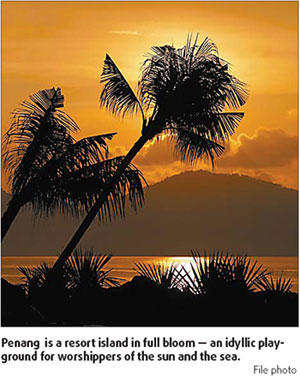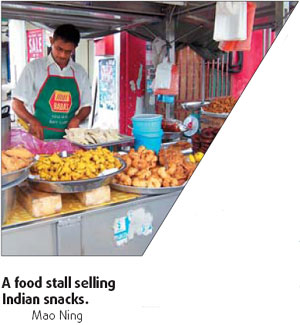Melting pot
While packing for my first trip to Malaysia, I was pondering what kind of clothes I should take with me. I had been warned to wear trousers to the Malaysia Embassy in Beijing to apply for a visa, as one member from our group was turned away from the embassy for wearing a mid-length skirt that was slightly above the knee.
Considering Malaysia is a country with Islam as its official religion, I gave up my collarless and sleeveless blouses and decided to be more conservative, even though I was going to a tropical land.
However, when I landed in Penang Island in northwestern Malaysia, my destination of the trip, I was surprised to find that women were actually wearing all kinds of outfits: traditional, modern, ethnic and trendy.

In Penang, I saw some women wearing black chadors that hid all but their eyes. I was told they were visiting women from the Middle East countries.
Most Malay women wear colorful dresses with matching headscarves. Many wear jeans and a long sleeved blouse plus the headscarf. It was an interesting scene to see policewomen or other working women in uniforms wearing colorful headscarves.
What these women wore was indicative of Penang's mix of strong Western influences and colorful ethnic cultures, as the Malays, Chinese and Indians form the majority of its population.
While three days is not enough time to explore a foreign land, I found that a trishaw ride is one of the best ways to see Penang.
The trishaw picked us up from Fort Cornwallis, the financial center of Penang at George Town, the capital of Penang state. The leisurely paced 30-minute ride offered us a perfect opportunity to sample the charms of Penang - an exotic mix of various sights, cultures, buildings of old and new and lively sounds within the narrow streets.
Our destination was Lebuh Pasar, commonly known as "Little India". The smell of curries and the Bollywood-signatured songs from loud speakers filled every corner of the street. Small stores lined on both sides of the streets sold a large variety of India handicrafts and colorful textile, garments and saris.
The fancy garlands, trinkets and especially the colorful saris were quite alluring. I asked a saleswoman whether I could buy a sari scarf. She turned me down politely, explaining the scarf was actually a part of a garment set.
In this neighborhood there is also a little hawker center. The hawker stalls along this colorful and vibrant street offer tasty Indian snacks, like samosa and ghulab jamun.
As a stranger in the city, an amazing impression about Penang was the harmonious co-existence of people of different cultural and religious backgrounds. They eat and dress their own way. They go to their own temples and mosques. They speak their own languages. But they form a colorful and harmonious social landscape.
Since the Malays and the ethnic Chinese and Indians make up the majority of Penang's population, Buddhism, Taoism, Islam and Hindu are prominent. Temples of different styles are the most distinctive buildings in the city. Buddhist temples, mosques and Hindu temples are everywhere, featuring fine and delicate workmanship. They attract people's attention with their colorful and fancy styles.

As the most important ethnic group with the largest population, Chinese influence has always been evident in Penang. Strolling along the streets of the city, I often felt like I was not on foreign soil.
Many of the doorplates of houses and shops along the streets bear Chinese characters. Many street vendors can speak Mandarin. In the city, you don't need to worry about the language barrier or about getting lost.
The common languages of Penang, depending on social classes, social circles and ethnic backgrounds are English, Malay and Mandarin. "Most of us with Chinese origins can speak five languages and dialects including English, Malay, Mandarin, Minnan (Southern Fujian dialect) and Cantonese," says Walter Leow, our tour guide.
Chinese began to move to Penang 200 years ago. A large number of them came from East and South China's Fujian and Guangdong provinces. In Penang, many people of Chinese origin like to send their children to study in those Chinese schools where both spoken and written Chinese are taught.
Penang is also a paradise for food lovers. During my short stay of three days, I tasted a variety of local dishes including Malay, Indian and Nyonya (a local cuisine with Chinese influence) cuisines. When night falls, the whole city, which was quiet during the daytime, suddenly turns into a bustling one with food stalls and hawkers selling all kinds of foods.
As a tropical island, Penang is gaining popularity as a tourist resort both for its white sandy beaches, mountain forests, cheap living and slow-paced lifestyle. As hectic and busy as we all are in today's fast-paced lifestyles, Penang offers a real escape.
(China Daily 09/13/2007 page19)














